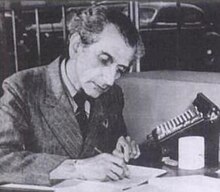

Cornelius Lanczos
| |
|---|---|
 | |
| Born | (1893-02-02)February 2, 1893 |
| Died | June 25, 1974(1974-06-25) (aged 81) |
| Nationality | Hungarian |
| Alma mater | University of Budapest University of Szeged |
| Known for | Lanczos algorithm Lanczos tensor Lanczos resampling Lanczos approximation Lanczos sigma factor Lanczos differentiator Lanczos–van Stockum dust |
| Spouse(s) | Mária Erzsébet Rump (1928–1939) Ilse Hildebrand (1954–1974) |
| Awards | Chauvenet Prize (1960)[1] |
| Scientific career | |
| Fields | Mathematics Theoretical physics |
| Institutions | University of Freiburg Purdue University Boeing Institute of Numerical Analysis Dublin Institute for Advanced Studies Frankfurt University |
| Thesis | Relation of Maxwell's Aether Equations to Functional Theory (1921) |
| Doctoral advisor | Rudolf Ortvay |
| Other academic advisors | Loránd Eötvös Lipót Fejér, Erwin Madelung |
Cornelius (Cornel) Lanczos (Hungarian: Lánczos Kornél, pronounced [ˈlaːnt͡soʃ ˈkorneːl]; born as Kornél Lőwy, until 1906: Löwy (Lőwy) Kornél; February 2, 1893 – June 25, 1974) was a Hungarian-Jewish, Hungarian-American and later Hungarian-Irish mathematician and physicist. According to György Marx he was one of The Martians.[2]
He was born in Fehérvár (Alba Regia), Fejér County, Kingdom of Hungary to Jewish parents,[citation needed] Károly Lőwy and Adél Hahn. Lanczos' Ph.D. thesis (1921) was on relativity theory.[3] He sent his thesis copy to Albert Einstein, and Einstein wrote back, saying: "I studied your paper as far as my present overload allowed. I believe I may say this much: this does involve competent and original brainwork, on the basis of which a doctorate should be obtainable ... I gladly accept the honorable dedication."[4]: 20
In 1924 he discovered an exact solution of the Einstein field equation representing a cylindrically symmetric rigidly rotating configuration of dust particles. This was later rediscovered by Willem Jacob van Stockum and is known today as the van Stockum dust. It is one of the simplest known exact solutions in general relativity and is regarded as an important example, in part because it exhibits closed timelike curves. Lanczos served as assistant to Albert Einstein during the period of 1928–29.[4]: 27
In 1927 Lanczos married Maria Rupp. He was offered a one-year visiting professorship from Purdue University. For a dozen years (1927–39) Lanczos split his life between two continents. His wife Maria Rupp stayed with Lanczos' parents in Székesfehérvár year-around while Lanczos went to Purdue for half the year, teaching graduate students matrix mechanics and tensor analysis. In 1933 his son Elmar was born; Elmar came to Lafayette, Indiana with his father in August 1939, just before WW II broke out.[4]: 41 & 53 Maria was too ill to travel and died several weeks later from tuberculosis. When the Nazis purged Hungary of Jews in 1944, of Lanczos' family, only his sister and a nephew survived. Elmar married, moved to Seattle and raised two sons. When Elmar looked at his own firstborn son, he said: "For me, it proves that Hitler did not win."
During the McCarthy era, Lanczos came under suspicion for possible communist links.[4]: 89 In 1952, he left the U.S. and moved to the School of Theoretical Physics at the Dublin Institute for Advanced Studies in Ireland, where he succeeded Erwin Schrödinger[5] and stayed until his death in 1974.[6]
In 1956 Lanczos published Applied Analysis. The topics covered include "algebraic equations, matrices and eigenvalue problems, large scale linear systems, harmonic analysis, data analysis, quadrature and power expansions...illustrated by numerical examples worked out in detail." The contents of the book are stylized "parexic analysis lies between classical analysis and numerical analysis: it is roughly the theory of approximation by finite (or truncated infinite) algorithms."[7]
Lanczos did pioneering work along with G. C. Danielson on what is now called the fast Fourier transform (FFT, 1940), but the significance of his discovery was not appreciated at the time, and today the FFT is credited to Cooley and Tukey (1965). (As a matter of fact, similar claims can be made for several other mathematicians, including Carl Friedrich Gauss.[8]). Lanczos was the one who introduced Chebyshev polynomials to numerical computing.
Working in Washington DC at the U.S. National Bureau of Standards after 1949, Lanczos developed a number of techniques for mathematical calculations using digital computers, including:
In 1962, Lanczos showed that the Weyl tensor, which plays a fundamental role in general relativity, can be obtained from a tensor potential that is now called the Lanczos potential.
Lanczos resampling is based on a windowed sinc function as a practical upsampling filter approximating the ideal sinc function. Lanczos resampling is widely used in video up-sampling for digital zoom applications and image scaling.
His book The Variational Principles of Mechanics (1949)[9] is a graduate text on mechanics. In the preface of the first edition it is described as a two-semester graduate course of three hours weekly.
| International |
|
|---|---|
| National |
|
| Academics |
|
| People |
|
| Other |
|